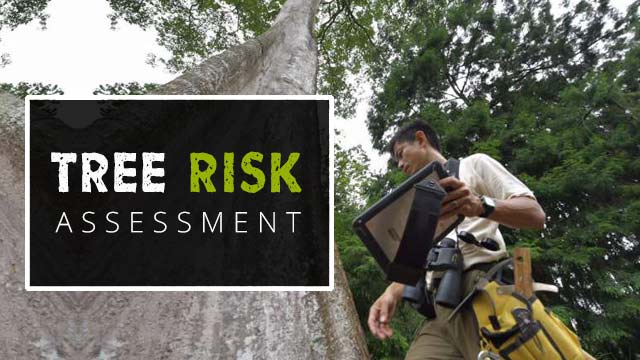Tree risk assessments are a visual assessment of a tree’s health by a certified arborist. They are done to determine the likelihood of failure of branches or the whole tree and the consequences of a failure.
The purpose of a tree risk assessment is to establish whether the tree in question poses an immediate threat to persons or property. If a threat is identified, the next step is to determine what mitigating options are there for the tree’s owner.

How do arborists assess the risk of a tree?
There are several factors that are considered when assessing the risk of a tree.
They are as follows:
Tree history – The history of the tree including previous branch failures is very important when assessing the likelihood of future failures. The presence of pests such as borer and white ants in the past can also give an insight into the current condition of the tree.
Trees vigor – The overall health and vigor of the tree can be established by taking a quick look at the overall canopy density, leaf coloring, and bark condition. The Certified arborist can also look at the amount of deadwood currently in the tree and the way old pruning wounds have healed themselves.
If the tree is still spritely and healing well, plus has a canopy density that is on par with other specimens of similar age, then the overall health can be determined as good.
Species profile – Taking into account the tree species is just as important as a case-by-case risk assessment. There are some trees that are renowned for being shallow-rooted and blowing over in a stiff wind. A good example of this would be the Eucalyptus nicholii1.
The species of tree in question is a very important factor when diagnosing the overall risk of failure and will be taken into account by the consulting arborist inspecting the tree.
Crown density – A thinning crown is the first sign a tree is not doing so well. Also known as crown die-back it is the top-center branches of the tree that will appear to have a lot less leaf density than the rest of the tree.
If a tree is struggling in any way, crown dieback is the canary in the coal mine.
Potential targets – If the tree in question is in the middle of a paddock and would not damage anything or harm anyone if it fell, the overall risk would be downgraded. Arborists are not just talking about the likelihood of failure (although that is a factor) we are assessing the risk of the tree to persons or property.
Likelihood of failure – After looking at the tree’s history and its overall health, the arborist will give the tree a score on how likely a branch or the entire tree is to fail. Low would be unlikely and high would be very likely.
Consequences of failure – Next are the consequences of tree failure. What are the targets directly under the tree? Is the tree in a suburban backyard or is it in a school where kids are playing? This weighs heavily on the arborists’ assessment and mitigation options.
If the only target of the tree is a fence or small shed, then they might lean towards preserving the tree or recommending a remedial prune. If it has to potential to harm or kill a person, they will more than likely recommend the removal of the tree.
Mitigation options – This would again depend on the consequences of failure. If the likelihood of failure is moderate and the consequences are grave, the most reasonable option would be to remove the whole tree or remove the branches at risk of failure.
An arborist is always trained to do their best to save trees where possible, but when it comes to weighing up between risks to someone’s life and removing the tree, the community’s safety must always come first.
Do risk assessments include an arborist report?
This would depend on whether the risk assessment was only asked to be carried out by the customer or whether the city has requested it as part of a permit request or a DA approval.
If it is only the customer requesting it, there is no real need for an arborist report. They will end up costing more money for the same determination and recommendations by the arborist.
This would include a risk assessment sheet like this one filled out by the arborist.
If the city is fighting to keep the tree, and you have requested it to be removed on grounds of personal and public safety, they might ask for an arborist report with a risk assessment included.





Do all arborists do risk assessments?
No, not really. There are two main categories of arborists;
a) Working arborist – Runs tree services and mainly does trimming and removal work.
b) Consulting arborist – Does arborist reports, tree inspections, safety reports, Pest treatments, etc.
They also have different qualifications.
Working arborist – Certificate III in Arboriculture
Consulting arborist – Diploma in Arboriculture
You will find about 1/3 of all tree services are qualified enough and capable of carrying out a risk assessment, so you will need to just ring around and ask a few companies if they do risk assessments and how much they charge.
How to find a cheap consulting arborist
GoTreeQuotes is a FREE service that matches customers with the best-priced local tree services.
We make it work by getting previous users to vote on who was the best price. Based on their votes, we curate a list of arborists in all cities that are well-priced and have a great customer service record.
We have found some social review services cannot be trusted and we do our best to match customers with the best local consulting arborist at the best price.
Click here to fill in the 2-minute form and get 3 obligation-free quotes from local arborists.
- SelecTree, UFEI, (2024) Eucalyptus nicholii Tree Record <https://selectree.calpoly.edu/tree-detail/555> Accessed: 01-03-2024.










